All Aboard The Merry-Go-Round! Texas, Oklahoma Deserting The Big 12 To Set Off The Next Major Conference Realignment?
By Simon Carroll
Our head of College Football content Simon Carroll speaks to some of the brightest CFB minds the UK has to offer about the future of the Power 5 conferences following Texas and Oklahoma’s decision to leave the Big 12:
Monday Bombshell

On Monday, The University of Texas and University of Oklahoma officially handed in their notice to Big 12 commissioner Bob Bowlsby, informing him they do not intend to renew their grants of media rights following their expiration in 2025. Essentially, they announced their intention to leave the conference. Texas and Oklahoma were founder members of the Big 12 upon it’s inception back in 1996, and are without doubt the two biggest programs in the conference, both on and off the field; Texas is the highest valued collegiate football program in the NCAA ($1.1bn), and Oklahoma come in seventh (£885.5m) – the other eight teams in the conference amount to a total value of around £1.5bn. Meanwhile, in the 25 seasons of it’s existence, Oklahoma or Texas have won the Big 12 (or at least shared it) seventeen times – mostly thanks to The Sooners’ fourteen conference titles.
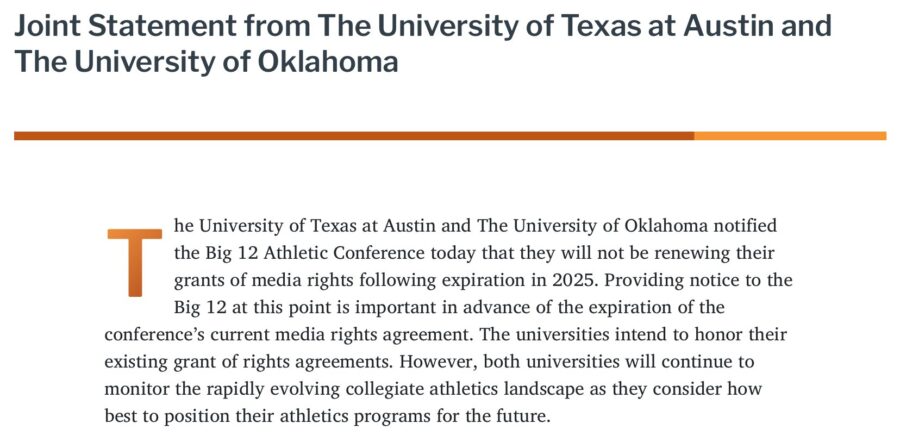
In recent seasons, the Big 12 has seen it’s star diminish; despite being one of the Power 5 conferences, only Oklahoma has represented the Big 12 in the college football playoffs, and the rest of the conference (Baylor 2019 notwithstanding) haven’t come close. Texas’ downturn on the football field may not have damaged it’s own reputation, but it certainly hasn’t helped it’s own conference. The Big-12 had the lowest income of the P5 conferences with $439m in 2019, and despite OU and UT sticking around during the last major realignment in 2010/11, have really never recovered from losing four teams (Colorado, Nebraska, Texas A&M, Missouri) and adding just two (TCU, West Virginia).
This defection of the two pre-eminent programs in their stable will be a huge blow to the future of the Big 12. Can they survive another turn on the realignment merry-go-round?
SEC Beckons For Texas & Oklahoma
It is the world’s worst kept secret as to where The Longhorns and Sooners are looking to make their new home. Rumours of a defection to the SEC have been mooted for weeks, and it appears that following them informing The Big 12 of their intention to leave, the two programs have made their application official:
NEWS | Statement from @SEC Commissioner @GregSankey: pic.twitter.com/6K9xW2sJ2o
— Southeastern Conference (@SEC) July 27, 2021
SEC commissioner Greg Sankey can pretend it’s news to his ears all he likes; teams the size of Texas and Oklahoma wouldn’t publicly declare their desire to join a conference if it wasn’t anything other than certain they would be accepted. Imagine the ridicule if they were to want out of the Big 12 only to be rejected by the SEC? No. Both these schools will have received some form of assurances they are welcome in college football’s biggest and best conference, turning the SEC into the first 16 team superpower.
The appeal of the SEC is obvious. More money, better prestige, and access to recruiting pipelines across some of USA’s most fertile states for football talent will, over time, allow Oklahoma and Texas to become richer, more powerful, and better on the field. For Oklahoma and Texas, these rewards dwarf the ability to dominate the Big 12 and have an open run at a playoff spot. Sure, it will be harder when you’re competing amongst the likes of Alabama, Georgia, LSU and Florida, but they will back themselves to compete relatively quickly. The CFP expanding to 12 teams also helps.
Not many programs would turn the heads of the SEC, but these two will. Oklahoma provides a new market for the conference to exploit, and have been one of the best teams in the nation the last decade. With Texas A&M already in the conference Texas doesn’t come with either of those strings to their bow, but as The College Chaps Podcasts’ Alex Chinery opines, they bring a lot more value in other sports – and adding the richest program in the NCAA to your portfolio comes with it’s own charm. No amount of crying from sensitive Texas A&M fans will stop this from happening; you best buckle up Aggies – big brother is back.

*Edit – things move quickly! On Thursday evening the The SEC Presidents & Chancellors voted unanimously to extend membership invitations to the University of Oklahoma and the University of Texas to join the SEC effective from July 1, 2025, with competition to begin in all sports for the 2025-26 academic year.
NEWS | The @SEC Presidents & Chancellors voted unanimously Thursday to extend membership invitations to the University of Oklahoma and the University of Texas to join the SEC effective July 1, 2025, with competition to begin in all sports for the 2025-26 academic year.
— Southeastern Conference (@SEC) July 29, 2021
The End For The Big 12?
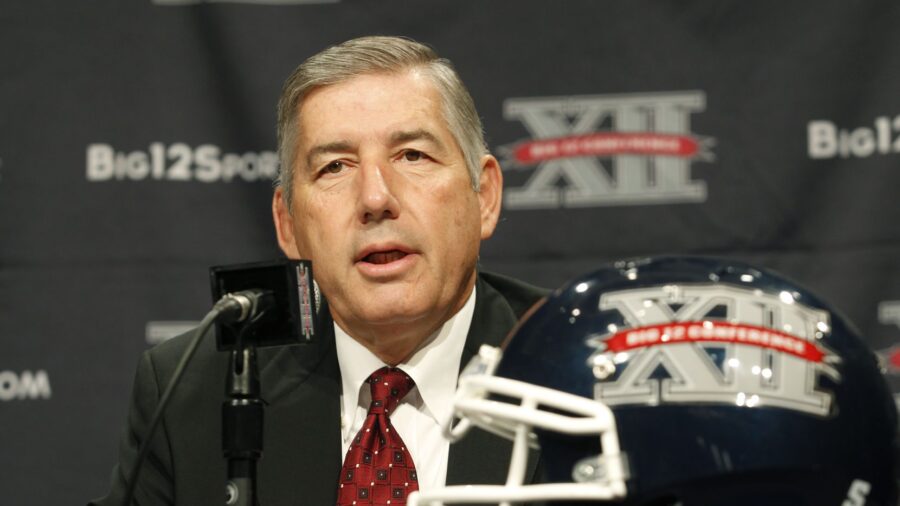
Big 12 commissioner Bob Bowlsby has seen his world cave in the last few days. A Big 12 conference without Texas & Oklahoma immediately loses it’s prestige; already considered a step behind the SEC, Big 10 and ACC, it’s not as if there are schools with the gravitas of Texas & Oklahoma ready and willing to replace them. In 2010, The Big 12 survived conference realignment despite losing four teams. Arguably the biggest of these four were Nebraska and Texas A&M, but neither fall into the same category of The Sooners or Longhorns. The conference dropped down to ten teams by adding just two; TCU from the Mountain West – a program riding high on the back of Andy Dalton and a Rose Bowl win in 2009 – and West Virginia from the doomed Big East. A definite downgrade, but it could have been a whole lot worse. They also had to concede defeat and allow Texas to have their own TV network in order to convince them to stay.
This time things are a lot more dicey. Replacing Texas & Oklahoma is an impossible task. My colleague George Somerville intimated that they could make an audacious invasion on the PAC-12, try to annexe the state of Arizona and steal the Wildcats and Sun Devils as a replacement. Having suffered it’s own loss of prestige the last few years, it isn’t outside the realms of possibility that The PAC-12 is vulnerable, and for Arizona State at least, the Big 12 – providing it remains a Power 5 conference – could provide an easier route to the college football playoffs.

I find it more likely that the SEC’s probable expansion to 16 teams spurs the other P5’s to look to do the same, and PAC-12 commissioner George Kliavkoff will likely be focusing on adding teams, not losing them. With a new TV-rights deal to be negotiated in the near future, this is a critical juncture for the conference. And with Larry Scott’s tenure seen as a ‘low ebb’, optimism is high on the Pacific Coast that better times are ahead.
The AAC
A more realistic opportunity for the Big-12 to bolster their ranks would be to add the best that the Group Of 5 conferences have to offer. Teams such as SMU, Houston and even Tulsa may be considered if they are looking to maintain a similar geographical identity, whilst Cincinnati, UCF and Memphis are all programs on the rise or enjoying sustained success at their current level. The common link between these schools? They all belong to the American Athletic Conference.
This path is fraught in of itself. Firstly, if the AAC is as strong as is suggested, why would these programs leave a thriving – albeit GO5 – conference and join a potential sinking ship in the Big 12? Furthermore, targeting AAC schools could be a sign of a lack of ambition to the rest of the Big 12 programs, and perhaps looking after their own best interests might be tempted to explore their options. Expressing disappointment in the actions of Texas & Oklahoma failed to disguise the true intentions of this statement from West Virginia’s AD Shane Lyons, as he extolled the virtues of the university and his athletic department – just in case anyone was interested:
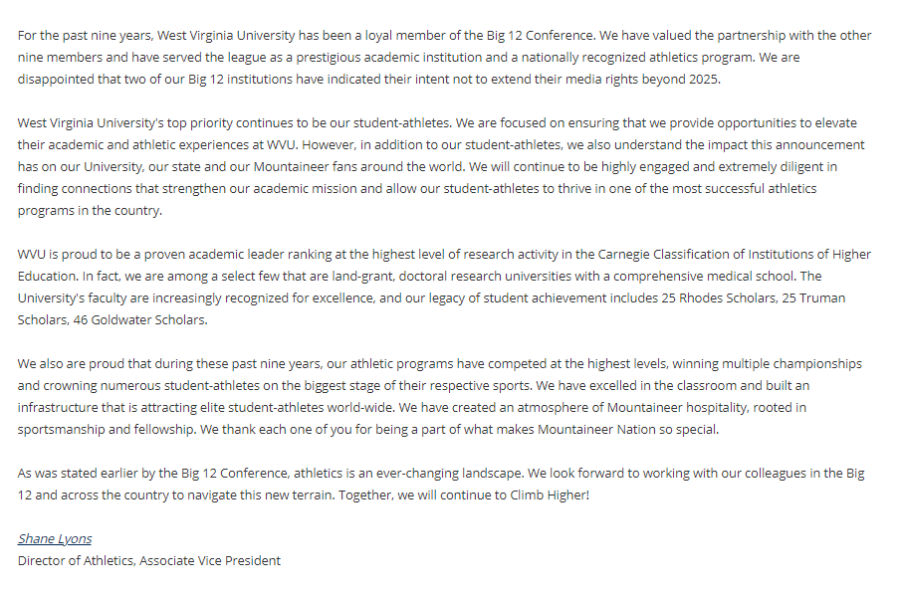
A sad, but much more likely scenario, is that the defection of Texas and Oklahoma marks the beginning of the end of the Big 12 conference. Bowlsby is already putting out fires, sending cease and desist letters to ESPN who they claim are encouraging other programs to depart for their own financial gain. Whether or not we wait until 2025 to see the Big 12 dissolve is yet to be seen, but there is no doubt that this outcome would leave the AAC in a strong position to lay claim to being the fifth biggest conference in college football. In an expanded playoff format, that opens doors for a conference – that has only been in existence since 2013 – they could only dream of a few years ago. And rather than the Big 12 taking teams from them, it seems far more realistic the Athletic American Conference becomes a new home for programs currently in the Big 12.
.@SINow has obtained the cease and desist letter that the Big 12 sent to ESPN.
— Ross Dellenger (@RossDellenger) July 28, 2021
In it, commissioner Bob Bowlsby says that ESPN has reached out to at least one of the eight remaining Big 12 members in an attempt to convince the school to leave in wake of the Texas and OU exit. pic.twitter.com/j50gEBPWBY
A New Dawn
Much like the last significant era of conference realignment, the first moves likely create a domino effect that will see many more programs change conference than just Texas and Oklahoma. With the SEC heading to 16 teams, it feels likely that the remaining three Power 5 conferences – and the AAC – will attempt to follow suit over the next few seasons. After discussing the possibilities with some of the UK’s leading writers of College Football content, here is how I see the CFB landscape should the demise of the Big 12 become reality:
SEC: Adds Texas, Oklahoma

2025 is still a long time from now, but after the 14 current members of the SEC voted unanimously to extend invitations to Texas & Oklahoma, their move to the SEC is all but confirmed. For all the reasons listed above, The Longhorns and Sooners fit well within the SEC. But it could also alleviate an issue that has irked SEC fans for a while, and that is the lopsided scheduling that the conference currently uses. Split into the East and the West, each school has eight conference games – six against the other teams in their division, and two from the opposite division. Out of those two non-divisional games, one is a permanent opponent who they play each season. That allows for rivalry games, but it also means you only play one of six other opponents on a yearly cycle, and a team like Alabama might only visit Athens to play Georgia once every twelve years.
Adding two more teams would likely create four ‘pods’ of four teams in the SEC. These pods would be roughly geographical, allowing state rivalries to be maintained. Teams would play the three other teams in their pod once a year. Programs would then play two teams from each of the other three pods on a rotational basis, increasing the total conference games on a schedule to nine. An example of the pod system would look something like this:
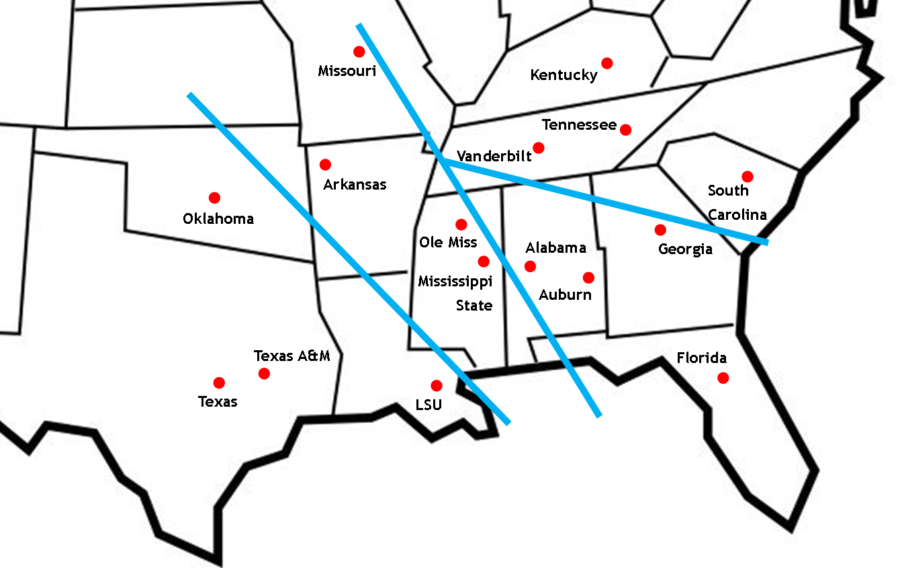
Bringing aboard Texas and Oklahoma would maintain the SEC as the NCAA’s most prestigious conference and cement their long-term future amongst the college football elite. Which other conference could try and keep pace?
Big 10: Adds Iowa State, Kansas

Did you know that the Big 10 raked in more money than the SEC last year? Their southeastern neighbours may currently wear the crown as the biggest and best, but their Midwest counterparts are not far behind. Being home to football heavyweights Ohio State, Michigan and Penn State will always make the Big 10 a force to be reckoned with, and the dissolution of the Big 12 may be seen as an opportunity to enter the fray and add a couple more programs to their ranks.
Could they target the PAC-12? Perhaps. As mentioned, it’s a make or break moment for the conference. But unlike the Big 12, if the Big 10 are going to ruffle feathers and make a move on the PAC-12 it will be for two of their elite programs. And when it comes down to it, I just don’t see Washington, USC, UCLA, Oregon or Stanford breaking rank. The history feels too entrenched.
The Big 10, even though they might want to, doesn’t particularly need to add more blue-chip programs when it comes to football; the product speaks for itself. But two names from the Big 12 may interest them for different reasons. Iowa State would provide current member Iowa with a real rival in the conference – the two schools battle it out for the Cy-Hawk trophy each year as an out of conference scheduled game. The rivalry is one of the oldest in College Football dating back to 1894, and ‘owning’ that rivalry would be a win in terms of TV audiences for the conference. The two schools are just a couple of hours drive apart, and would pretty much lock up the state in terms of recruiting. And despite the Hawkeyes being the dominant program, Matt Campbell has made the Cyclones a force to be reckoned with since his arrival in 2016.

The other team they could steal from the Big 12 might raise an eyebrow or two. Kansas have been the whipping boys of their conference on the football field for almost it’s entire 26 years of existence. But on the basketball court they are considered one of the premier programs in all the NCAA, with 3 national titles and over 2,300 wins on their resume. The Big 10 proudly boasts some historically top basketball programs in Ohio State, Indiana and Michigan State, and adding Kansas would make them the best basketball conference in the country.
Both these schools are ‘AAU’ universities, an association that distinguishes elite academic schools and their dedication to research, something the Big 10 have traditionally looked for in their members. Adopting the pod system, here’s what four divisions in the conference could look like:
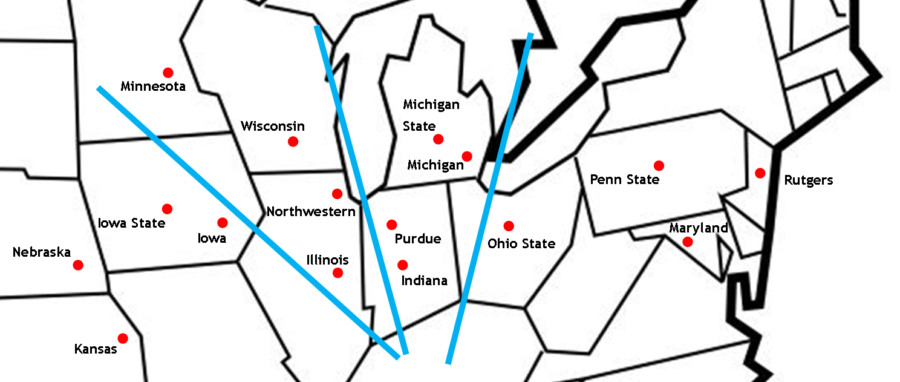
ACC: Adds Cincinnati, West Virginia

Geographically, the ACC makes too much sense for West Virginia to go anywhere else. Already feeling like something of an outcast in the Big 12, The Mountaineers came from the Big East and need to get back to playing teams from that area on a weekly basis. It would allow them to resume their rivalry with Pitt and recommence the ‘Backyard Brawl’ series with the Panthers, which was last played in 2011. Interestingly, they have got a four game series scheduled for 2022-2025.
If one team has potentially outgrown the AAC, it’s Cincinnati. Many people are linking them to the Big 10, and despite their lack of AAU status, Pro Football Network’s Oliver Hodgkinson believes that ultimately money may prove to be the overriding factor:

Despite agreeing that the upcoming battle for teams is going to make a lot of conferences readjust their priorities, I still think the Big 10 opts for the prestige of Kansas over the Bearcats. The ACC might shoot their shot for Notre Dame to be the 16th team in their conference, but independence suits the needs of the Fighting Irish and it’s likely they turn the offer down. I can see them turning to Cincinnati to fill the void; Ohio borders Pennsylvania, West Virginia and Kentucky so fits the bill, and the football team is flying high under the direction of Luke Fickell.
A four division pod system could look something like this:
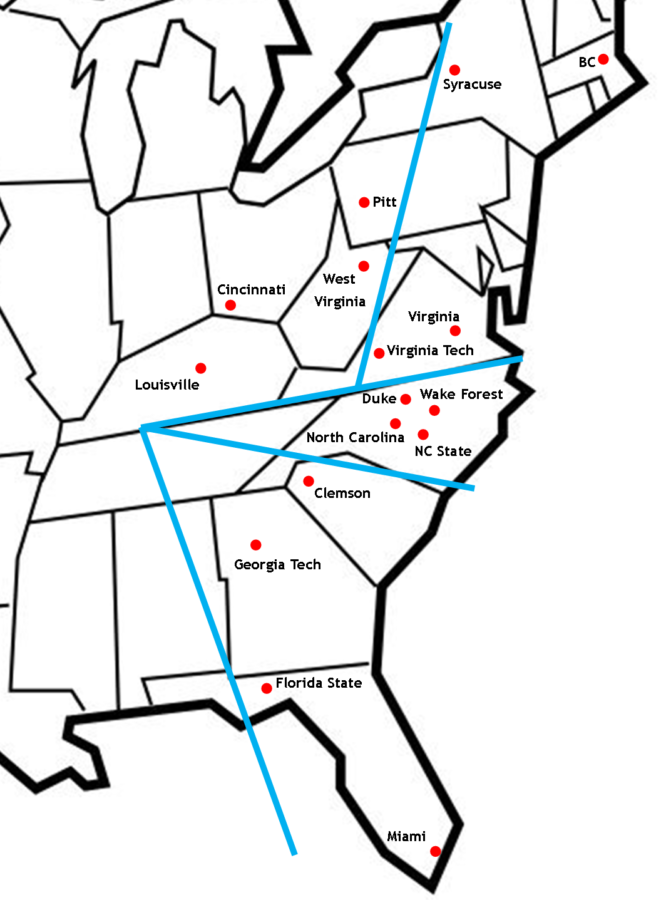
PAC-12: Adds Oklahoma State, TCU, Kansas State, North Dakota State

The PAC-12 is the biggest unknown of the upcoming conference realignment. Whilst I don’t anticipate they lose any teams, I also don’t think they’ll be able to be particularly choosy when it comes to adding programs to their conference either…
Texas and Oklahoma notwithstanding, Oklahoma State probably provides the best football program available from the Big 12. Mike Gundy has turned the Cowboys into a consistently tough to beat program who have challenged for conference honours on multiple occasions during his tenure. A similar case could be made for Gary Patterson and TCU, who on their day have shown they can beat anyone in front of them despite playing second or third fiddle on the in-state recruiting pecking order. Whilst these programs would find it tough to immediately challenge at the top of the PAC-12, they could certainly emulate the likes of Utah, who have slowly become a force since their introduction to the conference a decade ago.
Seen as the PAC-12 would be making inroads to the heart of central USA with moves into Texas and Oklahoma, they could look to do the same further north. Kansas State aren’t anyone’s idea of a powerhouse program but they know how to compete with modest resources. The Bill Snyder era saw many a Wildcat hit the NFL, and in Chris Klieman they have a head coach who will look to do the same. Klieman came to Manhattan in 2019 after five glorious seasons as head coach of FCS North Dakota State, which adds a further intriguing wrinkle when I throw The Bison in there as the 16th and final team the PAC-12 should bring aboard…

My good friend and Full 10 Yards college football expert Lee Wakefield is a PAC-12 enthusiast, and last month wrote his own article on conference realignment here. North Dakota State was a suggestion he made that I am unashamedly stealing. I must admit I had never considered NDSU as an option for the PAC-12, but if they are able to acquire the other three schools mentioned it makes too much sense not to run at the dominant FCS program of the last ten years. The Bison would complete the inland growth of the conference from North to South and give them a new market and school that has a huge following.
I would be concerned that NDSU might resist such overtures, being comfortable at the lower level and being a big fish in a small pond. But this isn’t the Mountain West calling; it’s the PAC-12. Joining a conference with the likes of Stanford and USC, with the money and prestige that comes with it, could be difficult to turn down.
Creating four division pods for what would be the ‘PAC-16’ isn’t so easy, but here’s one suggestion that should help keep old Big 12 and state rivalries intact at least:
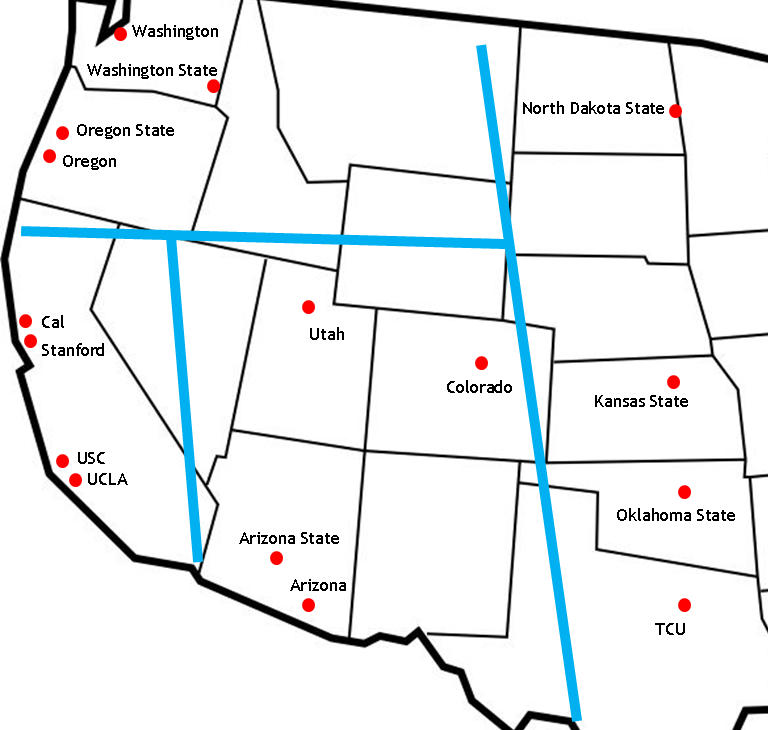
AAC: Loses Cincinnati, Adds Baylor, Texas Tech, BYU

The American Athletic Conference might not be able to join the big four in jumping to sixteen teams in one go, particularly if they lose Cincinnati. But adding three for an immediate increase to 12 teams would be a great start for what would be the defacto fifth conference in the NCAA. Sat somewhere between the ‘Power 4’ and the ‘Group of 4’ as it would be, the AAC would be primed to take advantage of the playoffs’ expansion to 12 participants.
This would make the fall for some of the former Big 12 teams much more palatable. Whilst Baylor and Texas Tech might feel it as something of a demotion, they would join a strong conference and immediately be competitive. I find it hard to believe that the playoff committee would ignore an undefeated AAC team in favour of supplying all twelve teams from the ‘Super Conferences’, and as such that exposure to the promised land will help these programs attract better recruits and the conference will get stronger and stronger.
BYU has been an independent school since the last great conference realignment, and maybe it’s time to find a home once again. They are another team who would fancy their chances in the AAC and would be an ideal fit for a conference looking to scoop up ‘the best of the rest’.
————————————
So there you have it. How the future of college football looks from the eyes of me. Will it end up this way? I highly doubt it. What we do know is that it will likely be a few years before the dust settles, whether the Longhorns or Sooners join the SEC in 2025 or earlier. In which case, you’ll have forgotten about my wayward predictions – unless it miraculously comes to pass, in which case I will remind you all on a weekly basis. Either way, it’s going to be a mini-series of drama and intrigue that I need injecting straight into my veins.

